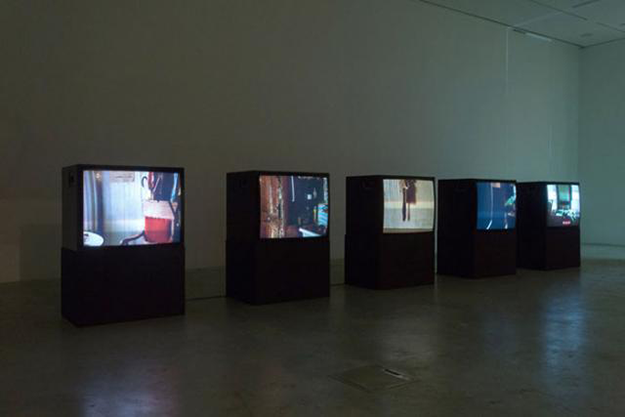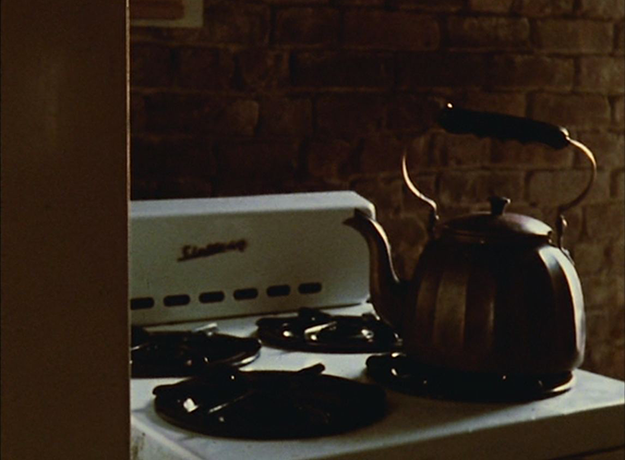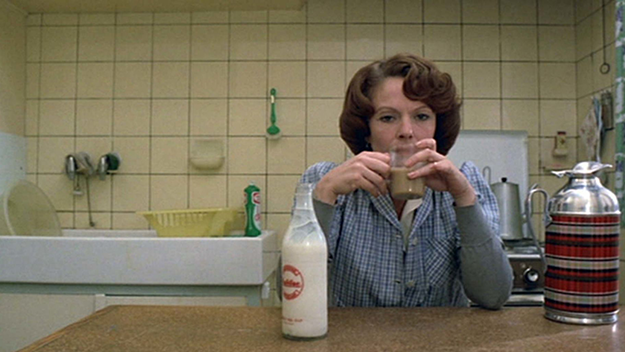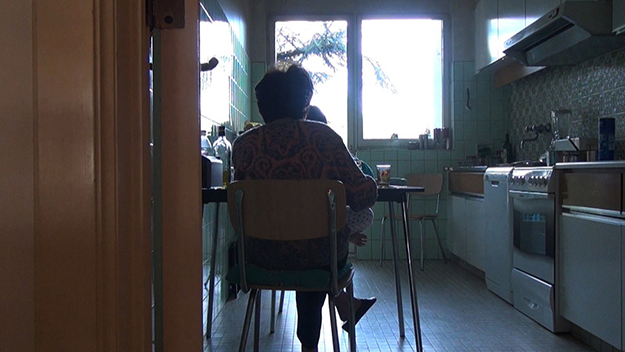Interview: Claire Atherton
Beginning with Letters Home in 1986 and continuing through No Home Movie, editor Claire Atherton worked closely with Chantal Akerman for almost 30 years on numerous fiction films, documentaries, and installations. In addition to From the East (1993), Le Captive (2000), and other work with Akerman, Atherton has also edited films with a wide range of directors, young filmmakers, and students. Her work was honored with a retrospective at the Grenoble Cinémathèque in 2013.
At the 22nd City of Women festival in Ljubljana, Akerman’s La Chambre (“The Room”) was shown, edited, and staged by Atherton at the MG+MSUM, in collaboration with the Belgian M HKA. Film Comment spoke with Atherton at the opening of the installation about collaborating with Akerman, the intuitive process of filmmaking and editing, including Akerman’s final film.

La Chambre, the installation
How does La Chambre, the installation, differ from screening it as a short film?
With installations, there is no beginning and no end. It goes on and on. It’s like time never passes. Chantal never wanted to show her films in galleries—except when she decided they were installations.
La Chambre is a film made in 1972, and at that time it was seen as an experimental film. In the ’70s, Chantal was in New York, and she was very interested in artistic currents of the time; for her, the kind of freedom that she discovered there was very important. There was this exhibition in Antwerp in Belgium and La Chambre was supposed to be exhibited in a circular room. All of the sudden, we thought that it would be more powerful to put it on five monitors. It was already an installation because we had already decided that it would be shown with no beginning and no end. It goes on and on. It’s like the time never passes.
When I say no beginning and no end, it doesn’t mean that there is no journey, no evolution. It just means there’s no start time and no end time. There are two ways of showing La Chambre, and I think the decision to show this installation as a five-monitor piece was like very linked to a specific moment in time and a certain space.
Could you tell me about working with time and space in the installation itself?
Yes—the exhibition in M HKA was named “Too far, too close” and the two images next to the title were from La Chambre and Nightfall Over Shanghai [2007], which is an exterior shot. So, yes, it was very focused on the division between the interior and the exterior spaces. I have a feeling about all of that, but I don’t really know the truth. For me, it’s obvious that it creates a multiplication of time. And via this multiplication of time, the space is changed. You have the feeling at one moment that it goes another way, but you don’t really know why.
But time was really important for Chantal’s first installation, too—she made it in 1995, from From the East, the film that we finished one year before. After we made the installation, we took some parts of the film, and we edited them again. They were four-minute clips, playing on 24 screens, grouped in eight triptychs of three monitors. I’m explaining all of this because it was really amazing for us, it was like magic, even if those words seem silly: Once we had edited the parts in a timeline, we started editing again, putting together several parts of the film and looking for echoes on the two existing monitors. After that, we would edit a third one and see how the three talked to each other. And then when the three were done, we would do the next one… As I said, that was in 1995, so we didn’t work with a computer, but with videotapes, and it was a homemade movie system. I had to be careful to push play for all the three monitors at the same time.
The first place it was shown at was London. When we went there, it all looked so big and amazing, and it was all synchronized, although it was very complicated to do that at the time. We discovered what the work that we had done looked like in another space. It was a very important moment for both of us, because we were discovering the space that we could construct, the real space. It was important to create the relationship between the viewer and the images, and the movements—you could view the installation from one point and then walk a bit to see it from another… The monitors were moving so some things were being echoed from everywhere. We had also used several sounds together and leveled them, so you’d have this and the 24 screens, a sort of chaos. I think it was very important, not just for her, but for other artists, too. It’s a piece which is really different from the film. If I had to decide how it should be shown, I think it should be shown with the film.

La Chambre
Speaking of the viewer, it seems that in Akerman’s films, there is no privileged point-of-view, created by reverse shots, or close-ups.
You don’t have to focus on a reaction or go closer to show something, but you always need to leave the space. For example, if Chantal would like people to know that someone has a watch, this particular watch in a movie, she would never focus on the watch. She would tell people to position themselves in a certain way and trust that this watch would be seen. That is actually something she once said in a film that she made, so that is why I’m giving it as an example. She doesn’t want to pretend—in the mainstream cinema, as you say, they show one shot and then the reverse shot, as if you are supposed to forget that it’s a film and think that it’s a story that you live in. In Chantal’s cinema, you never forget. You are always in the space of creation. And so, the fact that there is a direction of looking is important.
You spoke about welcoming chance when editing—can you talk about that?
It’s a way of working while trying not to lose anything you do. That means you have to be very organized and have to have a very precise technical process. But it doesn’t mean you understand everything—you need to be in a position of things coming to you without really knowing how. You work intuitively. It is a balance between thinking and feeling. I would try this and that, then Chantal would say something, so we tried that to see how it works. Suddenly, something is created. It’s by chance, but there’s always a reason. Suddenly, you understand what it is, what we wanted to do it. You let things come that you didn’t try to find consciously. So you have to be very precise, but at the same time, you also have to be very open.
The worst thing in editing is having to answer for everything you did. “Why are you doing that?”—“I don’t know.” I just let things come and I am happy with it. Chantal was always there when I was editing, but sometimes she was on the phone or on the internet or cooking, but then she would come and say one word, and—it was there.
You spoke about the lack, la manque, in your films, in connection with Chinese painting: these paintings are black-and-white, because nature’s true colors could never be painted truthfully, so rather they are left to the viewer’s imagination. How did you establish that in the editing room?
Perhaps there seems to be a basic contradiction with the Chinese painters, because they chose to paint in black and white, so it’s not exactly the same process. But five or six years ago—my first studies were in Chinese philosophy and Chinese language—I realized there was a very strong link between Taoism, Chinese painting, and Chinese writing. They say that painting is thinking the movement. So I liked to edit by creating movement and never closing the film. There are many links between this way of seeing art and this way of thinking and my way of practicing editing
So it’s not that I leave absence of space, it’s just a way of receiving the images and the sounds. Sometimes there is a part of you that wants to have a particular shot so you could construct something and it would make it easy. When you don’t have that link between two things, instead of saying “It’s missing,” you ask, “Why isn’t it there?” You start thinking about what it is. Maybe it’s yearning… I think this is very important in the arts in general, not showing everything. By asking yourself about the lack, you often find another way of understanding the movement of the film, a new angle to look at the images. A certain tension is being built—tension exists if there is a lack. Sometimes, the fact that a scene is lacking or that something is not shown, means something specific. You have to trust the underlying reason. It’s all part of the creative process, which is not a conscious process.

Jeanne Dielman
So these are the images between images that she spoke about, especially in connection to Jeanne Dielman [1975]?
Yes, it’s all part of the editing process I’m trying to describe. But I’m not thinking of those images between images, because otherwise I would get a little bit scared—it would be too much. But I feel that the images that I am working with and the edit that I am building is referring to imagination and other images. It’s something that you feel, something that you can’t really theorize, because if you do, you might lose something. It’s not that I don’t want to explain more, it’s just that it’s like a moving process inside of you and you know, and at the same time, if you go too far into describing or explaining, you lose something. So you have to try and see what emerges.
There is no vision in the sense of a concept. She never knew beforehand which two shots were going to be edited together. The words we used for images were not filmmaking words, we just used “beautiful,” “very strong,” or “light”… We liked to give names to shots, like “the green shot” or “the white shot”. We didn’t talk about what we wanted to see in the film. If we used words, it would stop something. Editing From the East—it’s a film shot in Moscow and Eastern Europe and she filmed a lot of people waiting in lines—we knew those people waiting would make us think of other people waiting somewhere else. At the same time, we didn’t say anything. We were just editing, creating something material.
A long time ago, I read about a dancer who would never want to express anything with his dance—he would say that the movement expresses it by itself. It was the same process with Chantal. Chantal didn’t want to use the images to express something; she would work around the images, the material of the images, they are full of a view that was expressed afterward. This way of working is working with something which is alive, and then the film stays alive. Then, it can talk to each of you differently. It’s universal because it talks to everybody, not because of a universal message.
The formal side of her films is actually very similar to André Bazin’s principles of realist filmmaking, though to a completely different effect. For one thing, her films are very political.
Yes, well—I think what is making me say I agree with you is that I was asked once if Chantal’s films were political. I was quite surprised, because for me, it’s evident. But it’s not because they are talking about political subjects. For me, Chantal’s films and films that I like in general are beyond their subjects.
For example: In South [1999], which was shot in the United States, she wanted to film the silence and the landscape, and how the history of this place is inscribed in it. When she arrived there, there was a commemoration of a racial murder, so she filmed that, too. The film is based on the dialectic between the present, the landscapes, this murder and the past that behind all of it. But it is not only a film about this murder, as some people say—she didn’t really know the commemoration would be happening; she just happened to be there at that particular moment. The way she films everyone who talks about what is happening now and what was happening before, is very respectful. Even the sheriff, who is saying some terrible things, is filmed with so much beauty and respect that you can understand what he is saying; it’s showing what humans are capable of, not hating anyone. She isn’t putting people in groups of good and bad, allowing the viewers to place themselves among the good, and think of the others being capable of bad things. That wouldn’t make you think, and Chantal’s films make us think. And what’s more political than making you think?

No Home Movie
Could you talk a bit about working on No Home Movie?
In No Home Movie, we really worked hard on the dialectic of calm and violence. You could say it’s the dialectic of inside and outside, or near and far. How can we be together even if we’re far away? Is it sometimes easier to be together when you’re apart? So calm and movement, and shock. I think what led us while choosing the editing points was really a physical sensation about ruptures.
The relationship between intimacy and the outside is the main thing in Chantal’s work. She touched on the big themes by speaking of little things and the intimacy. She shows us how to be human, how to deal with the world. It’s not supposed to make you forget that you’re alive or think that you’re living someone else’s life. She wants the viewer to work. The space is created for that. But it’s not that she films from afar because she wants to establish the space, it’s just the way she’s looking. She doesn’t want to show, she just wants to make you feel, and to make you feel time, too. When to her, people said they didn’t feel the time pass while they were watching her films, she didn’t like it. She wants you to feel it, she doesn’t want to steal your time.
The opening shot of the film with the desert and the wind is very intense, and it’s followed by a calmer, green shot of trees. As the film goes on, you see it differently than at the beginning. Did you work chronologically?
That was shot right after her mother’s death, in April, for a video installation that was to be shown in Jerusalem that was called From the mother to the desert. She didn’t want to say where she shot it, it’s not important. And yes, we worked chronologically. Because we had a lot of material, but it was only moments with Chantal’s mother. It wasn’t a film, it was just moments. When we edited the first image of the tree, it suddenly started to be a film. Chantal was always saying after this wind, this storm, we need the green calm. We need it.
In general, we never did extra shooting. Even if she wasn’t really sure she has enough, we edited it, and the film was there. As I said, there is la manque, and you work with that. But in this film, it’s a story that was still going on. And since we began editing just one month after Chantal’s mother’s death, Chantal had to go back to Brussels and to go to the apartment because she had papers to take care of. She was living in the apartment, so that’s why she kept on filming. So the last two shots were made during the editing. It happened when she went there again… It was not because she needed it, but she went there with the camera because she was always going there with the camera, and then she kept doing it, even if her mother wasn’t there anymore.
I thought No Home Movie had many elements of her previous films, like a kind of synthesis.
I don’t see it as a synthesis, but I think it’s true that I see it—for some people, No Home Movie was perhaps the first film they’ve seen by Chantal. That’s a bit bizarre, I think, because Chantal would never make this film as her first film. It’s like all her work is really linked to her relationship with her mother. And to the history of her mother. And also to the words that have not been said about this history and that she was carrying with her, and the images that she didn’t want to make and that’s also why she made her films with such distance and respect. It was images that she could deal with. She once said her father used to say, “There is nothing to say,” and her mother used to say, “There is nothing to dwell on.” She said that it’s with this nothing that she works.
In No Home Movie, she used the digital material, but it was more of a meeting between her and this material and not that she used digital material because you have to use it and you pretend that it is actually film. I think because the camera was very small and very easy to use, and because it was the end of her mother’s life, she took an intimate approach, but with all of the background of her other films and of their lives. In this film, her mother talks a lot and talks probably more about the war and what she had lived through than she did even in Chantal’s life. Her mother talks also a little bit in an installation which is called Marcher à côté de ses lacets dans un frigidaire vide. It’s an interview she made after a film, it was for the making-of of the DVD, and we agreed to film it in black and white and not always in focus, and we made an installation out of it, on two screens. So in this installation, her mother also speaks. But you don’t really see her, you just see parts of her.
So it was the first time that it’s so direct, that she speaks with her mother, and I think that she was only capable of doing that because it was the right time. She wouldn’t have done it as a first film. No Home Movie can be an echo to many other films: Jeanne Dielman deals with her mother, and News from Home [1977] was all about the relationship with her mother. It really is linked. There is something different, but something the same or at least very similar, too.
In No Home Movie, she was filming her mother knowing that she would lose her and so she was filming this way. It wasn’t premeditated as a film, she didn’t know that she would really make it. But she was filming and she was thinking as she was living. It shows that even if she doesn’t know she’s making a film, the images are so strong, so full of what she is living at that moment. After making those images, she didn’t know what they were. Some of them were on memory cards, phone, computers, it was messy. It was very complicated. In the scene where they eat, she just leaves the camera outside the kitchen and goes and talks with her mother. She forgot about it.
The first title for the film was Home Movie. She wanted it to be perceived as a homemade movie. There was no money, no big production. It’s just a movie, a home movie. And some people told us that made them think about home cinemas. So she said, let’s call it No Home Movie, it’s even stronger, it’s more true. That’s the way she was thinking, always very quick and deep. When we were editing the film, I was trying, and then she would just say one word and it was right. It was a very, very happy moment, the editing of No Home Movie. It could have been sad, but it was very happy. We were building something, we were laughing. Sometimes it was sad, but it was happy. That’s important to know.
Tina Poglajen is a freelance film critic. She likes going to film festivals.







